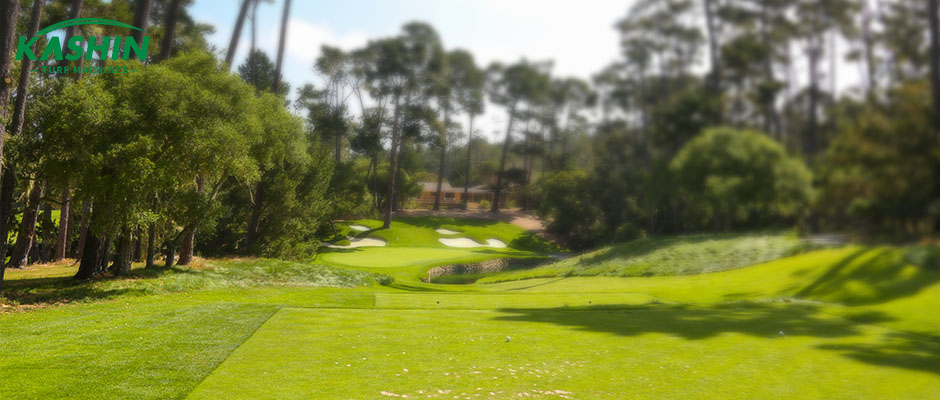1. Habits of cool-season lawn grass
Cool-season grass likes cool climate and is afraid of heat. It grows fast in spring and autumn and goes dormant in summer. When the temperature reaches above 5℃ in early spring, the aboveground part can grow. The optimum temperature for root growth is 10-18℃, and the optimum temperature for stem and leaf growth is 10-25℃; the root system stops growing when the temperature reaches 25℃. When the temperature reaches 32℃, the aboveground part stops growing. Cool-season grass growth requires more water and fertilizer supply, and most varieties prefer light to shade.
2. Selection of cool-season lawn grass species
The selection of cool-season grass species follows the principle of “suitable land and suitable grass”. Mixed sowing between species or varieties can increase the adaptability of the lawn. The meadow bluegrass is bright green and has slender leaves. Mixed sowing of three or more varieties can form a high-quality lawn. However, the water and fertilizer requirements are relatively high. The disease resistance and heat resistance in summer are generally not as good as those of tall fescue; the ornamental value of new varieties of tall fescue has been improved, but it is still rough compared with meadow bluegrass. Mixed planting of three or more varieties will make the lawn drought-resistant, heat-resistant and disease-resistant, and the water and fertilizer requirements are also lower than the former. Red fescue is shade-tolerant and heat-averse, so it can be appropriately mixed in cool places to improve the shade tolerance of the lawn; rough-stemmed bluegrass is the most shade-tolerant of all grass species, but it does not grow well in places with light and is suitable for cool places. The sowing amount of all grass species should not exceed the recommended sowing amount, meadow bluegrass 6-15g/m2, tall fescue 25-40g/m2. In order to see quick results, increasing the sowing amount is not conducive to lawn growth.
3. Watering requirements for cool-season lawn grass
Cold-season grass likes water but is afraid of waterlogging. Under the premise of ensuring sufficient water supply, the amount of watering should be adjusted according to the season and temperature, and it is very important to prepare the land well. When the grass turns green in spring, water it early and thoroughly to promote the greening of the lawn; spray water to cool down in high temperature in summer, prevent water accumulation after rain, and water when it is wet and dry appropriately, and avoid watering in the evening; extend the watering time in autumn until early winter.
4. Pruning of cold-season lawn grass
The stubble height should be greater than or equal to the recommended height of various grasses. Early grass is 1-2.5 cm, tall fescue is 2-4.5 cm, and the stubble height is appropriately increased by about 0.5 cm in shady places; the stubble height of the lawn in summer is appropriately increased by about 1 cm. The amount of pruning at one time should not exceed one-third of the grass height. For example, the stubble height is 8 cm, and the grass height reaches 12 cm. If more than one-third of the grass height is pruned at one time, it will cause varying degrees of damage to the lawn, and the lawn will gradually weaken.

5. Fertilization of cold-season lawn grass
Due to fast growth and frequent pruning, cold-season lawns should be top-dressed several times a year. Fertilize at least twice in spring and autumn, and then increase the number of fertilization in spring and autumn according to the situation; generally no fertilizer is applied in summer, and slow-release fertilizer (organic fertilizer or chemical fertilizer) can be used in early summer if necessary; in addition to the nitrogen, phosphorus and potassium compound fertilizer applied in the first spring and the last autumn, nitrogen fertilizer should be applied; in summer, do not apply nitrogen fertilizer multiple times due to grass weakness to avoid inducing diseases. Potassium fertilizer can improve the resistance of grass, and potassium fertilizer can be added every time nitrogen fertilizer is applied. Slow-release fertilizer nutrients continuously supply the lawn with balanced growth, while reducing the number of fertilizations and saving labor. Fertilization should be carried out using special fertilization machinery, which can make the fertilizer application accurate and even.
6. Weed removal
Before the lawn is planted, use a lethal herbicide (environmentally friendly) to completely eliminate weeds in the soil, which can significantly reduce the weeds in the lawn in the early stage.
7. Pests and diseases of cold-season lawn grass
The prevention and control of lawn diseases should follow the principle of “prevention first, comprehensive prevention and control”. First, it should be maintained according to reasonable maintenance measures, and then combined with pesticides for prevention and control. In summer, lawn diseases are more common and more harmful. You can spray pesticides to prevent them before they occur. That is, spray fungicides in April, May, and June. In summer, lawns grow weakly, and the existence of diseases is often ignored. Fertilizers are used instead of pesticides, which will aggravate the spread of some diseases. You should distinguish the situation and deal with it correctly.
Post time: Oct-21-2024
